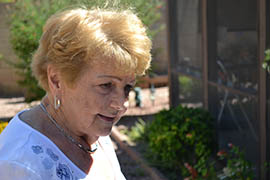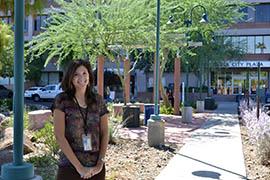Cronkite News has moved to a new home at cronkitenews.azpbs.org. Use this site to search archives from 2011 to May 2015. You can search the new site for current stories.
Cities offering rebates to encourage residents to xeriscape lawns
MESA – The smell of grass, the sound of sprinklers and the shade of three large ficus trees have all disappeared from Arthur and Jeananne Pastin’s yard. Instead, barrel cactuses, red bird of paradise shrubs and palo verde trees sprout from gray- and brown-flecked granite gravel.
Arthur is happy to be selling the lawnmower. Jeananne is glad the ficuses no longer block the Christmas lights. But the best part for both: a $500 check the city sent them to make the change.
“I think we’ve definitely done the right thing,” Jeananne said. “It makes me happy every day to see what we’ve done.”
This is one of almost 250 households that have taken advantage of Mesa’s Grass-to-Xeriscape Landscape Rebate program since it began in 2007. Becky Zusy, the city’s conservation specialist, said the financial incentive often changes people’s minds.
“For our customers who are on the fence, we hope that the rebate program will be the tipping point,” she said.
Mesa isn’t the only Valley city offering rebates for grass removal. Avondale, Chandler, Glendale, Peoria, Scottsdale and Tempe have similar programs.
Throughout the Southwest, green lawns are giving way to desert plants. David White, a senior sustainability scientist at Arizona State University’s Global Institute of Sustainability, said that even when rebates aren’t available people are still interested in conservation.
“There is a desire throughout the Southwest for both water services providers as well as residents to reduce consumption,” White said. “The best place to do that is outdoors, where as much as half of all consumption occurs.”
To be eligible for Mesa’s $500 rebate, homeowners must convert at least 500 square feet of healthy grass to desert landscape that includes at least 50 percent coverage by approved, water-conserving plants. Removing grass is only part of the goal; replanting the area is an important part of the transformation.
“We never want to promote hot and boring,” Zusy said. “We want beautiful, easy-to-maintain and shady landscapes.”
Scottsdale’s program has a slight difference: simply removing grass gets 25 cents per square foot and removing and replacing grass with water-conserving plants gets 50 cents per square foot, with a $1,500 maximum per property for either option.
Annie DeChance, public outreach manager for Scottsdale’s Water Resources Department, said that it’s not just about saving groundwater in that city, which has some of the highest water consumption per capita of any in Arizona.
“It’s in everybody’s best interest for all cities to work together to help educate customers about water use,” she said.
Paul Hirt, a senior sustainability scholar at ASU, said xeriscaping programs won’t be as effective as they can be unless cities put more money into rebates.
“These types of rebate programs actually do work,” Hirt said, “but they have to be aggressively invested in.”
Removing all grass isn’t a good idea either, Hirt said, especially in Phoenix, where concrete and asphalt create a “heat island” effect that keeps the city from cooling off at night.
“Some amount of grass and trees can help to reduce energy,” Hirt said.
Phoenix and Tucson don’t have rebate programs, but for different reasons.
Mary Lu Nunley, a public information specialist, said Phoenix is already meeting its water-conservation requirements and that many people want the city to remain an oasis in the desert.
“Part of the reason Phoenix doesn’t have rebates is because per-capita water consumption is well ahead of the curve,” she said. “So it doesn’t make financial sense to do it.”
Fernando Molina, Tucson Water’s public information officer, said that city has already landscapes to embrace its desert identity.
“Tucson doesn’t find a need for a xeriscape program because since the mid-70s it’s been an accepted way of life here,” he said.
But in Mesa, Zusy said, incentives are helping get more people involved in conserving water.
“You have to start somewhere,” she said. “Everyone can make a difference.”










